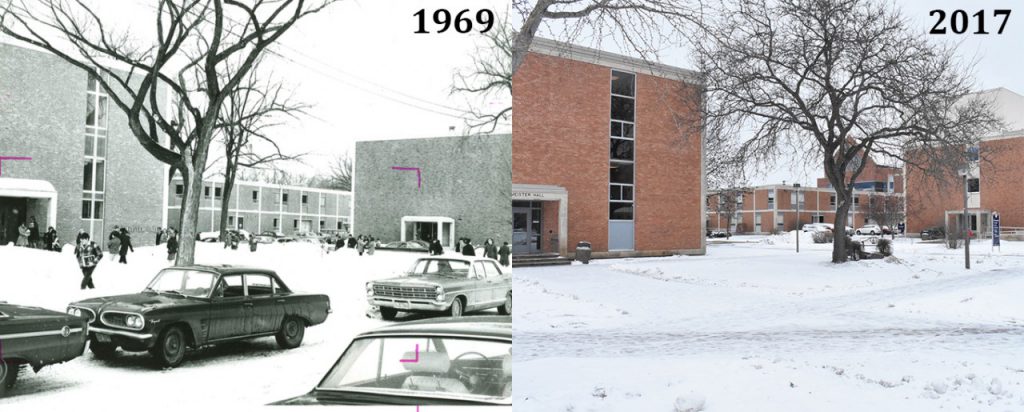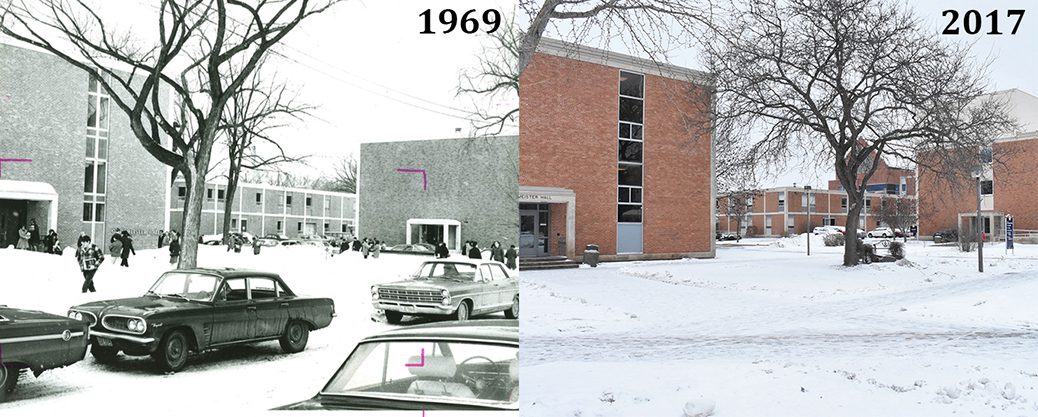by Allison Mueller
When Darrell Krueger began his presidency at Winona State University in 1989, he had big plans for the campus – plans that earned him the title of “absolutely crazy.”
The vice president of university advancement at the time, Gary Evans, said he and Krueger would often walk around campus, speaking to people and looking at the grounds. During the early 1990s, the streets bordering the university ran through the campus.
“I remember he and I were making that walk one day when he stopped and said to me, ‘We need to close all these streets,’” Evans said. “I remember saying specifically to Darrell, ‘You’re absolutely crazy… the city of Winona will never allow that to happen.’”
Krueger said he simply saw the need for the campus to match its surroundings.
“The river and bluffs are so beautiful, yet the campus had streets all the way through it,” he said.
Evans said once Krueger developed what campus would look like without streets, resources were needed to make it happen. After people began to support Krueger’s vision, Winona State went to the state university board for an allocation, and it was approved.
Since then, campus beautification at Winona State has been of high importance to faculty, staff and students.
While Krueger took the initiative to change the campus, he said when the first street was transformed into a wide sidewalk, “People started to see other possibilities.”
Over the next few years, donations were received from alumni, community members, faculty and staff to further beautify the campus. Krueger said some of the most well-known and enjoyed elements on campus were donations: the benches, gardens near the Performing Arts Center and Gildemeister Hall, Lauren’s Pond, gazebo and many trees.
After Krueger retired as Winona State’s president in 2005, Evans, who left Winona State in 1998, said the campus fell into “pretty serious neglect.” Eight years later, Evans returned for a three-year stint as interim vice president and heard the current president, Scott Olson, discuss the beauty of the campus in a university meeting.
“It was no question – the campus was, and is, beautiful,” Evans said. “The fact also remained that it was a pale resemblance of its former self.”
Olson made sure a budget was available for the maintenance department to transform the campus back into its previous state and maintain its beauty.
Evans explained upholding the image of Winona State to future Warriors as an “extremely important component” to future enrollment.
“It’s been proven over and over again that prospective students that come to look at Winona State are stunned by the beauty of campus,” Evans said. “That, combined with the beauty of the community, is responsible for recruiting a great deal of students to the university.”
As Olson began to place emphasis on the appearance of the campus, Jim Reynolds, a now-retired Winona State sociology professor, was placed as co-chair of the WSU Landscape Arboretum Committee.

According to Reynolds, the Arboretum is concerned with campus beautification as well as developing the campus to be representative of the diverse southeastern Minnesota biome.
The Arboretum’s goal is to promote this unique landscape on Winona State grounds, create opportunities for the campus to be used as a living classroom and laboratory, continue to develop the native species on campus and model ethical use of land and practices.
Reynolds said a big accomplishment for the committee was appointing an Arboretum director and landscape architect, Lisa Pearson, who has a “wealth of experience.”
At the start of January 2017, Reynolds passed his committee chair position to Pearson and Allison Quam, a Winona State faculty member. These women now manage a staff that includes a senior groundskeeper and horticulturist, turf and irrigation specialist, certified arborist, and student landscape workers.
Evans recalled a Winona State maintenance employee (Bill Meyer, a now-retired groundskeeper) telling Krueger, shortly after the street transformation, that he thought Winona State was close to having every tree native to Minnesota on the campus grounds. This thought turned into another campus goal for Winona State.
As the number of native trees grew over the years, a complete tree inventory has recently been done of the campus. The inventory reveals there are more than 1,500 trees on Winona State’s campus comprised of 143 species. Reynolds said it is important to maintain diversity in the university’s tree stock.
“We don’t want to develop a monoculture of one type of tree,” he said. “That’s not healthy.”
Two years ago, a rapid restoration of the entire university landscape was conducted. Reynolds said the majority of the funding for these significant expenditures came from a settlement with the DuPont Corporation.
Prior to the restoration, Winona State had used lawn fertilizer from DuPont that was mistakenly toxic to trees. Reynolds said Winona State lost around 100 trees due to the use of this fertilizer, and Winona State received a sizable settlement from the corporation in the nationwide lawsuit. The Arboretum used the settlement for the restoration, which involved hiring a Rochester firm to assess and prune the trees across campus.
Reynolds said the rapid restoration was “such a mammoth undertaking that our staff just wouldn’t have had the time to do. It involved a couple dozen people from firm devoting an intensive amount of time.”
The time and effort the university’s Landscape Arboretum has put into planting and maintaining the trees on campus, combined with involvement in Arbor Day activities, earned Winona State recognition as a Tree Campus USA the past three years.
In an effort to educate the public and its students about the trees on campus, the Arboretum sponsors tree tours in the summer and fall months. Many of the trees on university grounds display a label with its respective popular name, scientific name and a QR code to scan and give smartphone users more information and photos about the species of tree.
While strides have been made in beautifying Winona State’s campus, Reynolds explained the Arboretum is a long-term project that will continually evolve. This includes using an organic approach to maintaining the university’s landscape, transitioning away from commercial flowers to more native plants of southeastern Minnesota and developing a river landscape feature in the central part of the main campus.
Reynolds said these changes would enhance students’ learning in the landscape as an outdoor classroom and appeal to the public.
“We want to see Winona State’s campus become a destination point for travelers passing through the area,” Reynolds said.
Today, as tourists, community members, students, staff and faculty walk the sidewalks on campus to admire the bio-diversity and beauty, Evans emphasized the importance of Krueger’s definitive words during their stroll on campus in 1989.
Evans said there is no question that removing the roads was “the first critical step in beautifying the campus.”
While Krueger may have started the campus beautification initiative, he said it has taken “a whole community to make the Winona State campus as beautiful as it is now.”
Krueger said, “I’m very thankful to have been able to serve and have the support we had during those times from the city, state, faculty and staff, and the students. The students led a lot of these changes.”
Reynolds said the Landscape Arboretum Committee would like to see more student-engagement regarding projects related to their academic programs. He suggested there needs to be a new culture and attitude on campus about maintaining the landscape.
He said, “Everyone has to pitch in on this. Not just the landscape staff, but students, faculty and staff as well.”
With a tight budget and recent cuts, Evans said this is a threat to the Landscape Arboretum, just as any program.
“I would hate to see any less spent on campus beautification than is currently being spent,” he said. “I certainly hope that campus beautification is never again allowed to become deficient.”
